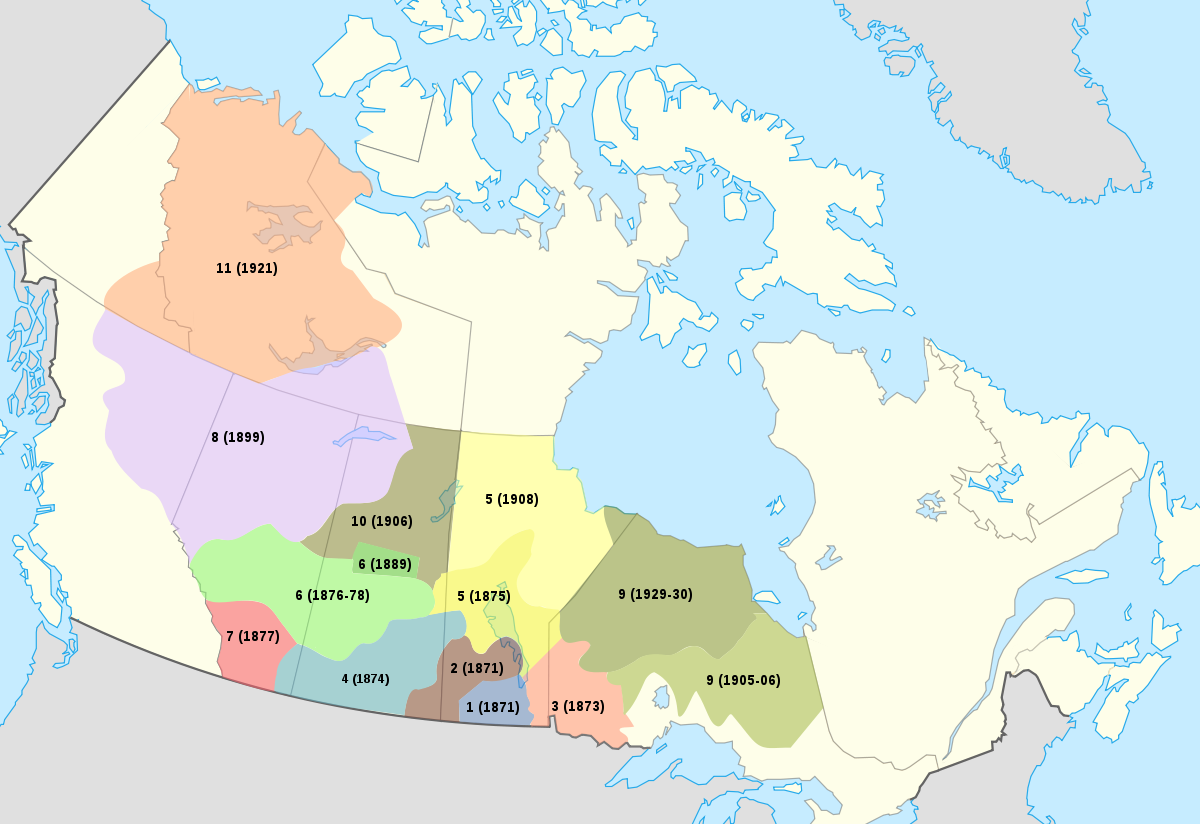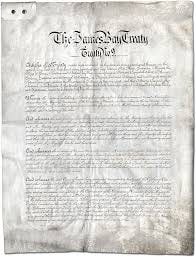Our Home and (Native?) Land - Part 5 "The Numbered Treaties"
The Treaties, at their core, involved the Surrender of Vast Amounts of Land
Much like its southern neighbour, the new Dominion of Canada believed that its future lay in its expansion across North America. While the unification of the British colonies of Canada, New Brunswick and Nova Scotia created a single block under the banner of the new Dominion of Canada in 1867, most political parties had expansionist views which called for the annexation of Rupert's Land, the huge territory covering the Hudson Bay watershed. In fact, during the first session of the first Dominion Parliament, several politicians called for the acquisition of Rupert's Land from the Hudson's Bay Company.
The rapid expansion of the United States across the West alarmed many Canadian politicians who feared that the United States would annex Rupert's Land. The fears of American expansionism were real as several different groups throughout the American territories openly called for the annexation of the Hudson Bay Company lands. This was compounded by a belief that any expansion by Canada across the Prairies was detrimental to US interests.
Recognizing the significance of western expansion for Canada's economic prosperity, the acquisition of Rupert's Land became a top priority. Without this vast territory, Canada would be confined to a small corner of the continent, unable to tap into the abundant resources and potential of the Prairies. This limitation would hinder the country's ability to attract immigrants, boost its population, and drive commerce. Immediately after Confederation, negotiations commenced between the Dominion, Britain, and the Hudson's Bay Company to secure the acquisition of the Company's Charter to Rupert's Land.
Through the Rupert's Land Act of 1868 and the Northwest Territories Transfer Act in 1870, the Dominion successfully obtained full control over Rupert's Land, as granted by the British. Following the establishment of Manitoba in 1870, the Macdonald Government took further steps to establish the administrative framework for the Northwest Territories. The Northwest Territories Act expanded Canada's legal jurisdiction beyond Manitoba, providing provisions for an administrative structure and the application of Canadian law throughout the Territories.
However, despite the legal transfer of the Northwest Territories to Canada, it remained a region devoid of Canadian authority, still predominantly inhabited by Indigenous peoples. While the Dominion had acquired the title to Rupert's Land, it faced the challenge of exerting its influence and jurisdiction over the area.
Upon the transfer of the HBC charter, Canada assumed the responsibility of addressing all Aboriginal claims to land. In order to fulfill this obligation, the Crown engaged in negotiations for eleven treaties between 1871 and 1921, following the framework established by the 1850 Robinson Treaties. These treaties encompassed the vast region stretching from the Lake of the Woods to the Rocky Mountains and all the way to the Beaufort Sea.
Similar to the Robinson Treaties, the Numbered Treaties, as they came to be known, offered Aboriginal communities reserve lands, annuities, and the continued right to hunt and fish on unoccupied Crown lands in exchange for their Aboriginal title. However, these treaties also included provisions that resembled the civilisation programs implemented in central Canada.
Each treaty included clauses mandating the establishment of schools or the presence of teachers to educate Aboriginal children. Additionally, agricultural implements were promised to assist the Aboriginal signatories in transitioning to an agricultural lifestyle. The intention was to encourage Aboriginal communities to settle on reserve lands and form sedentary communities, where they could learn agriculture and receive an education.
The Treaty Commissioners emphasized that the reserves were designed to aid Aboriginal people in adapting to a life without the buffalo hunt. The government pledged to support them in this transition by providing tools and other farming implements necessary for agriculture.
The transfer of the HBC charter led to Canada assuming the responsibility of addressing Aboriginal land claims. Through the negotiation of the Numbered Treaties, the Crown offered reserve lands, annuities, and hunting and fishing rights in exchange for Aboriginal title. These treaties also included provisions for education and agricultural assistance, aiming to facilitate the transition of Aboriginal communities towards a sedentary and agricultural lifestyle.
The treaties, at their core, involved the surrender of vast amounts of land. A total of 11 Numbered Treaties were negotiated during this period, with Treaty 11 being the final one in 1921. From the perspective of the Federal Government, signing these treaties brought the Aboriginal people of the Northwest under the jurisdiction of Canada and its laws. The early Numbered Treaties, specifically Treaties 1 through 7, served as a means for the Department of Indian Affairs to implement assimilation policies in the Northwest. The later treaties, on the other hand, facilitated the opening of the North and provided access to valuable natural resources.
However, not all Aboriginal leaders in the Northwest Territories were content with the terms offered by the Crown's representatives. One notable example is Chief Big Bear, a respected Cree leader who expressed dissatisfaction with the terms of Treaty 6 and initially refused to sign it. For seven years, Big Bear and his followers roamed freely across the Prairie, exerting pressure on the Crown to renegotiate the treaties with more favorable terms for First Nation signatories. Faced with the challenges of disappearing buffalo, reliance on Northwest Mounted Police rations, and a dwindling number of followers, Big Bear eventually agreed to sign an adhesion to Treaty 6 in August 1883 and settle on a reserve. Big Bear and his followers were among the last major non-treaty Aboriginal groups in the Prairies.
Although the treaties negotiated between 1871 and 1921 were based on the framework of the 1850 Robinson Treaties, they were not all identical. While they shared a general structure and purpose, each treaty had unique clauses that reflected the specific circumstances and interests of the parties involved. These agreements were the result of negotiations between parties with sometimes conflicting goals, leading to the inclusion of provisions that were hard-fought and tailored to meet the needs of each party.
The earliest treaties negotiated in Western Canada, such as Treaties 1 and 2 in 1871, had fewer clauses compared to the later treaties. For instance, these treaties did not explicitly state that the First Nation signatories would retain the ongoing right to hunt and fish in the treaty area. Additionally, the amount of reserve lands allocated per band was fixed at 160 acres per family of five, a provision that was repeated only in Treaties 1, 2, and 5, which covered present-day Manitoba. Furthermore, the initial treaty annuity was set at $3 during the time of the treaty signings, while all other Numbered Treaties had an annuity of $5. These differences, along with complaints regarding promises not included in the written text of the treaties, led to the passage of an order-in-council in 1875. This order increased the annuity to $5 and addressed the grievances raised by the First Nations.
While the treaties negotiated between 1871 and 1921 followed the model of the 1850 Robinson Treaties, each treaty had its own unique clauses that reflected the specific circumstances and interests of the parties involved. The early treaties had fewer provisions compared to the later ones, and adjustments were made over time to address concerns and ensure fairness in the agreements.
In 1873, Treaty 3 was negotiated at Lake of the Woods, marking Canada's third attempt to secure a treaty for the lands between Lake Superior and the Red River. Due to the strategic importance of these lands and the intense negotiations with the First Nations, Treaty 3 had different clauses compared to the treaties signed in 1871. This treaty provided a larger allocation of reserve land, with 640 acres per family of five, and guaranteed rights to hunt and fish on unoccupied Crown lands. The annuity was set at $5, and there was a higher one-time gratuity of $12 per person. Additionally, a yearly allocation of $1,500 was designated for the purchase of ammunition and twine.
The terms of Treaty 3 served as the starting point for Treaty 4, which was negotiated at Fort Qu'Appelle the following year. The differences between the two treaties were relatively minor, such as allowing for four headmen instead of two in Treaty 4, providing a larger gratuity for chiefs and headmen, including trapping along with hunting and fishing rights, and allocating $750 for the purchase of ammunition and twine.
When negotiations began for the lands around Lake Winnipeg, Treaty 3 once again served as the starting point. The terms of Treaty 5 were similar, with the exception of a reserve land allocation of 160 acres per family of five, as seen in Treaties 1 and 2. Additionally, there was a one-time payment of $500 for ammunition and twine, agricultural implements, and tools.
Following the disruption of the telegraph line construction, Treaty commissioners were sent to negotiate Treaty 6 for the rich agricultural lands of the North Saskatchewan River. While Treaty 6 included the usual terms, such as a reserve land allocation of 640 acres per family of five, it also had three unique clauses. These included the agreement to maintain a medicine chest for the use of the band, providing assistance during times of famine and pestilence, and granting a supplement of $1000 per year for the first three years to assist in land cultivation once the bands had been surveyed.
When the final southern treaty was concluded in 1877, the three special clauses of Treaty 6 were not repeated. However, Treaty 7 differed from the other Numbered Treaties in various ways. While the other treaties included provisions for agricultural implements, Treaty 7 signatories expressed a desire to focus on ranching instead of farming. As a result, the treaty commissioners agreed to reduce the allocation of agricultural implements and seed stock in exchange for an increased number of cattle, with some exceptions for bands interested in farming. Another significant difference in Treaty 7 is that the Crown agreed to pay for teachers' salaries instead of maintaining school buildings. The only guarantee in the treaty was that the government would cover the cost of teachers' salaries.
The treaties negotiated between 1871 and 1921 had unique clauses that reflected the specific circumstances and negotiations with each First Nation. Each treaty had its own variations in terms of reserve land allocation, hunting and fishing rights, annuities, and additional provisions. The differences between the treaties were shaped by the strategic importance of the lands, the desires of the First Nation signatories, and the evolving negotiations between the parties involved.
Over the next couple of months we will dig a little further into each of the numbered treaties, and the legal and cultural battles for each.
Darren Grimes
Our Home and (Native?) Land - Part 6 “Let them rob me”
Treaty No. 1 was made with the understanding that the Treaty would be in place for “as long as the sun shines, the grass grows, and the river flows...
Keep reading with a 7-day free trial
Subscribe to Indigenous Opinions to keep reading this post and get 7 days of free access to the full post archives.






